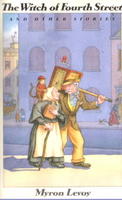The Lower East Side History Project has a lot by lot history of the block.
The Village Voice chose it as one of the best in the city
The West Side has its Lincoln Center. Nice, but a little garish for our taste. The East Village, on the other hand, has East 4th Street, a block-long cultural retreat boasting no fewer than 12 theaters, eight dance and rehearsal studios, and a screening room for avant-garde films. East 4th Street between the Bowery and Second Avenue is where La MaMa, the New York Theater Workshop, the Rod Rodgers Dance Company, and Millennium Theater all present their works. Sandwiched in between are an array of fine shops and artisans, including Barbara Shaum (the expert leather maker), a pair of marvelous musical instrument shops, the 4th Street Food Co-op, and the great KGB Bar. This little Bohemia was long ago targeted by Robert Moses's wrecking ball, and much of the housing—mostly six-story tenements—passed into municipal hands. But it was rescued by the efforts of the Cooper Square Committee, a local citizens' group that has never given up trying to create and save affordable housing and commercial space even in the torrid real estate market of the East Village. The result is a veritable People's Republic of East 4th Street—right here in Bloomberg Town!




















